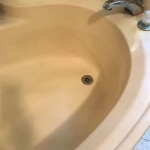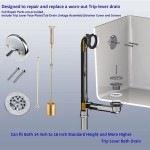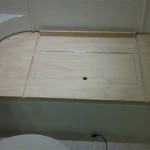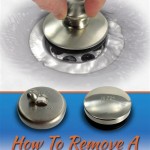Changing A Bathtub Faucet Cartridge: A Comprehensive Guide
A leaky bathtub faucet is a common household problem that can lead to wasted water, increased water bills, and potential damage to surrounding fixtures. Often, the culprit behind a persistent drip is a worn or damaged faucet cartridge. While calling a plumber is always an option, replacing the cartridge is a relatively straightforward task that most homeowners can accomplish with the right tools and a little patience. This article provides a comprehensive guide to identifying the type of cartridge you need and the steps involved in replacing it, helping you restore your bathtub faucet to its leak-free glory.
Before beginning any plumbing repair, it is crucial to understand the basics of faucet anatomy. A faucet cartridge is a cylindrical component inside the faucet that controls the flow of water. When you turn the faucet handle, the cartridge moves to allow water to pass through the faucet spout. Over time, mineral buildup, corrosion, and general wear and tear can damage the cartridge, leading to leaks. Identifying the correct type of cartridge is paramount. There are several common types, including compression, ball, cartridge, and ceramic disc. Knowing which type your faucet uses will ensure you purchase the correct replacement and avoid compatibility issues.
Identifying Your Faucet Cartridge Type
Determining the type of faucet cartridge is the first and most crucial step in the replacement process. Each type has a distinct design and operates differently. Here’s a breakdown of the most common types:
Compression Faucets: These are the oldest and simplest type, characterized by two separate handles for hot and cold water. Each handle controls a stem with a rubber washer at the end. When you tighten the handle, the washer presses against the valve seat, shutting off the water flow. Compression faucets are relatively easy to identify because of their separate hot and cold handles. They are also prone to dripping due to the wear and tear on the rubber washers.
Ball Faucets: Typically found in kitchen sinks but sometimes in bathtubs, ball faucets have a single handle that moves up and down to control the water flow and side to side to adjust the temperature. The handle connects to a slotted ball inside the faucet body, which controls the mixing of hot and cold water. These faucets are identifiable by their single, ball-shaped handle controlling both flow and temperature.
Cartridge Faucets: These faucets also use a single handle for both temperature and flow control, but instead of a ball mechanism, they use a cylindrical cartridge. Moving the handle slides the cartridge up and down to control water flow and rotates it to adjust the temperature. Cartridge faucets are generally recognized by their smooth handle operation and the absence of a visible ball joint. To definitively identify a cartridge faucet, you may need to look for a cartridge retaining clip or nut under the handle.
Ceramic Disc Faucets: These are the most modern and durable type of faucet. They feature a single lever that moves up and down for flow control and side to side for temperature adjustment. Inside the faucet, two ceramic discs slide over each other to control the water flow. Ceramic disc faucets are easily identifiable by their wide, cylindrical bodies and smooth, quarter-turn operation. They are also known for their reliability and resistance to drips.
Once you have identified your faucet type, the next step is to determine the specific cartridge model required. The best way to do this is to remove the old cartridge and take it to a hardware store or plumbing supply store to find an exact match. Alternatively, you can look for a manufacturer’s stamp or model number on the faucet body or under the handle assembly. If you cannot find a model number, take detailed pictures of the cartridge from different angles and compare them with online images or consult with a plumbing professional.
Steps for Replacing a Bathtub Faucet Cartridge
After you've identified and acquired the correct replacement cartridge, you can proceed with the replacement process. These steps outline the general procedure; however, variations may exist based on the faucet model. Always consult the manufacturer's instructions or a professional if you are unsure.
Step 1: Shut Off the Water Supply: This is the most critical step. Locate the shut-off valves for the hot and cold water lines that supply the bathtub faucet. These are typically located under the sink or in an access panel behind the bathtub. Turn both valves clockwise until they are completely closed. After turning off the water supply, turn on the faucet to relieve any residual pressure in the pipes. If water continues to flow, the shut-off valves may not be fully closed or may be faulty.
Step 2: Prepare the Work Area: Cover the bathtub drain with a cloth or stopper to prevent small parts from falling down the drain. Gather your tools, which typically include a screwdriver set (both flathead and Phillips), an adjustable wrench, pliers, a cartridge puller (optional but recommended), and a small container to hold screws and small parts.
Step 3: Remove the Faucet Handle: The method for removing the faucet handle varies depending on the faucet type. For single-handle faucets, there is often a small setscrew located on the side or underneath the handle. Use a small Allen wrench or screwdriver to loosen the setscrew and then gently pull the handle off the faucet body. For two-handle faucets, there may be a decorative cap covering a screw. Pry off the cap with a flathead screwdriver and then unscrew the screw to remove the handle.
Step 4: Remove the Cartridge Retaining Clip or Nut: Once the handle is removed, you will typically find a retaining clip or nut that holds the cartridge in place. For cartridge faucets, the retaining clip is usually a small, U-shaped piece of metal that slides into slots on either side of the cartridge. Use a pair of pliers or a small screwdriver to carefully remove the clip. For other faucet types, there may be a retaining nut that needs to be loosened with an adjustable wrench. Be careful not to damage the nut or the surrounding faucet body.
Step 5: Remove the Old Cartridge: With the retaining clip or nut removed, you should be able to pull the old cartridge out of the faucet body. If the cartridge is stuck due to mineral buildup or corrosion, you may need to use a cartridge puller. A cartridge puller is a specialized tool that grips the cartridge and allows you to apply more force without damaging the faucet body. Follow the instructions that come with the cartridge puller. If you don't have a cartridge puller, you can try gently wiggling the cartridge back and forth while pulling it out. Be careful not to break the cartridge inside the faucet body.
Step 6: Clean the Faucet Body: Once the old cartridge is removed, inspect the inside of the faucet body for any mineral buildup or corrosion. Clean the inside of the faucet body with a mild abrasive cleaner and a soft cloth. Be sure to remove any debris that could interfere with the new cartridge's operation.
Step 7: Install the New Cartridge: Lubricate the new cartridge with plumber's grease to ensure smooth operation and prevent it from sticking. Align the cartridge with the faucet body and gently push it into place. Make sure the cartridge is fully seated and aligned correctly before proceeding.
Step 8: Reinstall the Retaining Clip or Nut: Secure the new cartridge by reinstalling the retaining clip or nut. Make sure it is properly tightened to prevent leaks. If you are using a retaining clip, ensure it is fully seated in the slots on either side of the cartridge. If you are using a retaining nut, tighten it with an adjustable wrench, but be careful not to overtighten it.
Step 9: Reinstall the Faucet Handle: Place the faucet handle back onto the faucet body and secure it with the setscrew or screw. Make sure the handle is properly aligned and tightened to prevent it from coming loose.
Step 10: Turn on the Water Supply and Test for Leaks: Slowly turn on the shut-off valves for the hot and cold water lines. Check for leaks around the faucet handle, spout, and connections. If you detect any leaks, immediately turn off the water supply and recheck the cartridge installation and connections. Tighten any loose connections and repeat the test. If the faucet drips, the cartridge may not be fully seated or the retaining clip/nut may not be properly secured.
Troubleshooting Common Issues
Even with careful attention to detail, some challenges may arise during the cartridge replacement process. Here's how to address common problems:
Cartridge Stuck: As mentioned earlier, mineral buildup and corrosion can cause the cartridge to become stuck inside the faucet body. If you're unable to remove the cartridge by hand, try using a cartridge puller. If you don't have a cartridge puller, you can try soaking the area around the cartridge with vinegar or a penetrating oil lubricant. Let it sit for a few hours to help loosen the buildup before attempting to remove the cartridge again.
Incorrect Cartridge: If you purchase the wrong cartridge, it will not fit properly or function correctly. Double-check the faucet type and cartridge model number before purchasing a replacement. If you're unsure, take the old cartridge to a hardware store or plumbing supply store to ensure you get the correct match. Attempting to force an incorrect cartridge into the faucet body can damage the faucet and make it difficult to remove the cartridge later.
Leaks After Replacement: If you experience leaks after replacing the cartridge, there are several possible causes. First, ensure that the cartridge is fully seated and the retaining clip or nut is properly secured. Check the O-rings or seals on the cartridge for any damage or misalignment. If the O-rings are damaged, replace them with new ones. Also, inspect the faucet body for any cracks or damage that could be causing the leaks. If the faucet body is damaged, you may need to replace the entire faucet.
Handle Difficult to Turn: If the faucet handle is difficult to turn after replacing the cartridge, it could be due to improper lubrication or misalignment. Apply plumber's grease to the cartridge before installing it to ensure smooth operation. Also, make sure the cartridge is properly aligned with the faucet body and that the handle is securely attached. If the handle is still difficult to turn, the cartridge may be defective and need to be replaced.
Replacing a bathtub faucet cartridge is a manageable DIY project that can save you money and prevent water wastage. By carefully identifying the type of cartridge, following the step-by-step instructions, and troubleshooting any potential issues, you can successfully restore your faucet to its optimal condition. Remember to prioritize safety by shutting off the water supply before beginning any plumbing repairs. If you encounter any difficulties or are unsure about any step, consult with a qualified plumber.

Fixing Faucets How To Replace A Difficult Tub Faucet Cartridge
Bath Tub Cartridge Replacement Ifixit Repair Guide

Replace A Moen Shower Cartridge Fix Leaky Tub Faucet
:strip_icc()/remove-cartridge-wrench-9833526f-b2b3558c245a4f909572d43a618d1e67.jpg?strip=all)
How To Replace A Shower Cartridge Fix Your Faulty Faucet
Bath Tub Cartridge Replacement Ifixit Repair Guide
Bathtub Faucet Cartridge Replacement Mister Plumber

How To Replace A Single Handle Shower Cartridge In 3 Steps
:strip_icc()/removing-handle-faucet-34180fd2-180b43c19a84467fa88ebaf08beaa438.jpg?strip=all)
How To Replace A Shower Cartridge Fix Your Faulty Faucet

How To Replace A Delta Tub Shower Cartridge Tutorial No More Leaky Faucet Super Simple Diy

Moen Shower Faucet Cartridge Replacement Lever Is Hard To Turn
Related Posts








